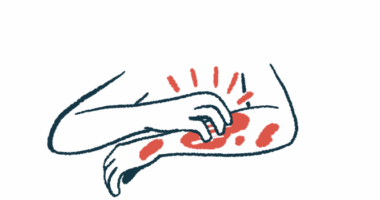Livmarli benefits seen across PFIC types, trial data show
Treatment eased itching, reduced blood bile acid levels

Treatment with Livmarli (maralixibat) leads to significant clinical benefits for people with progressive familial intrahepatic cholestasis (PFIC) across a wide range of disease types based on their genetic cause.
That’s according to final published results from the Phase 3 MARCH-PFIC clinical trial (NCT03905330) that backed the therapy’s recent approval for all PFIC types.
The findings were published in The Lancet Gastroenterology & Hepatology in a study titled, “Maralixibat in progressive familial intrahepatic cholestasis (MARCH-PFIC): a multicentre, randomised, double-blind, placebo-controlled, phase 3 trial.”
“We are pleased to see these data published and recognized by The Lancet as they demonstrate meaningful improvements in many clinical signs and symptoms seen in PFIC patients,” study author Pam Vig, PhD, chief scientific officer and head of research at Mirum Pharmaceuticals, the therapy’s developer, said in a company press release.
Mirum touts MARCH-PFIC as the largest trial to show the benefits of an ileal bile acid transporter (IBAT) inhibitor — the therapy class to which Livmarli belongs — across different PFIC types, including some that have not been previously studied.
New treatment option
“Livmarli presents a new non-surgical treatment option in PFIC with strong efficacy data and safety demonstrated across a range of PFIC types, which is important for patients with PFIC types previously unstudied,” said Alexander Miethke, MD, the study’s first author and director of the liver transplant program at Cincinnati Children’s Hospital.
PFIC refers to a group of rare disorders in which bile, a digestive fluid, can’t flow properly out of the liver, where it’s made, into the intestines during early life. Called cholestasis, this stalled bile flow causes bile acids to build up in the liver and leak into the bloodstream, resulting in progressive liver damage and pruritus, or itch.
Each type of PFIC is caused by mutations in specific genes involved in bile production and/or transport. Among the several known types, the most common are PFIC type 2 (50%-60%); type 3 (30%-40%); and type 1 (10%-20%). A minority of PFIC patients don’t have a defined genetic subtype.
As an oral IBAT inhibitor, Livmarli works to promote bile acid excretion in the feces, preventing buildup in the liver and bloodstream and easing symptoms of cholestasis.
It is approved in the U.S. for PFIC patients ages 5 and older, as well as for certain people with Alagille syndrome, another rare genetic liver disease marked by cholestasis. In the European Union, where Livmarli is also cleared for Alagille, Mirum is seeking approval for PFIC patients 2 months and older.
The MARCH-PFIC trial tested the daily oral therapy against a placebo over a six-month period in 93 children and adolescents, ages 1-17, with persistent pruritus and signs of progressive liver disease. Participants’ median age was 3, and 55% were girls.
While PFIC type 2 made up the largest proportion of participants, several other PFIC types were also represented, including types 1, 3, 4, and 6, as well as a minority without genetically defined disease.
“Most of these disease types are studied here for the first time,” the researchers wrote.
Benefits seen after two weeks
The study’s main goal was to assess whether Livmarli eased morning pruritus severity among PFIC type 2 patients relative to placebo, as assessed by changes in the caregiver-reported ItchRO(Obs) severity score from the month prior to study’s start (baseline) to the last three months of treatment.
That goal was met, with Livmarli resulting in a significantly greater drop in itch scores — by 1.1 points — relative to that observed with placebo in that patient subgroup. Similar findings were observed across the larger group of all patients, where Livmarli was associated with a significantly greater, 1.2-point drop in itch scores compared with placebo.
Livmarli-treated PFIC type 2 patients also showed a clinically meaningful, significantly greater reduction in blood bile acid levels, meeting a key secondary goal, and this was also observed in the larger patient group.
Similar Livmarli benefits were observed in the subgroup of patients with PFIC types 1, 3, 4, and 6, and in those with no identified genetic cause of disease.
Across all patients, Livmarli-associated reductions in pruritus and bile acids were observed as early as two weeks into the trial and maintained throughout the study. The therapy was also linked to significant reductions in morning pruritus, clinician-reported scratching, and sleep disturbances, as well as growth improvements, relative to placebo.
“These data advance our understanding of Livmarli’s potential to provide meaningful improvements in pruritus and a number of parameters impacting patients with various PFIC types,” Miethke said.
Other outcome measures also tended to favor Livmarli, including reductions in bilirubin, a marker of liver disease. According to Mirum, improvements in bile acids and bilirubin levels are known to be predictors of survival without the need for liver transplant.
“The clinically meaningful reductions in serum bile acid and bilirubin levels also signify the potential for improvements in native liver survival in PFIC, a step forward in considering the long-term care and health of patients with PFIC,” Miethke said.
The most commonly reported side effect with Livmarli was diarrhea, which was usually mild and temporary.
Participants completing involving MARCH-PFIC were able to enroll in an open-label extension study called MARCH-ON (NCT04185363), where received Livmarli for up to two years. Data so far showed that the therapy’s benefits were generally sustained long-term.






